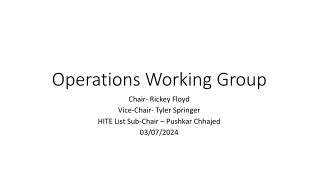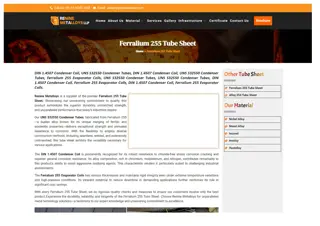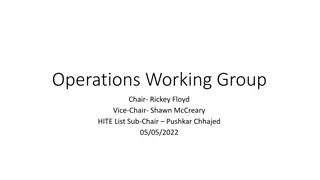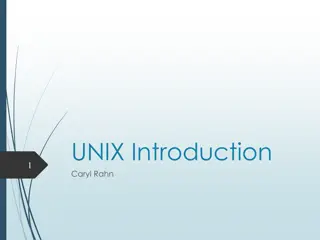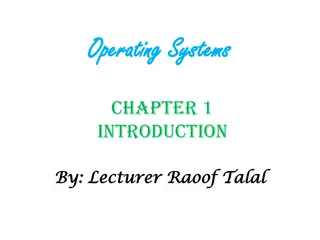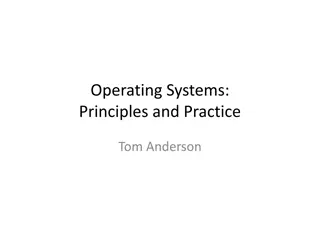
NOGRR 245 and 255 Update: Operating Guidelines Changes
The NOGRR 245 and 255 updates involve changes in the operating guidelines effective from specific dates. They address ride-through performance failures, investigation processes, model validation, and timelines for compliance. The updates also cover equipment installation, data retention, maintenance, and testing requirements. ERCOT's involvement, Resource Entities' responsibilities, and OEM coordination are highlighted. Additionally, FAQs clarify applicability of sections and requirements for dynamic reactive devices and disturbance monitoring equipment.
Uploaded on | 6 Views
Download Presentation

Please find below an Image/Link to download the presentation.
The content on the website is provided AS IS for your information and personal use only. It may not be sold, licensed, or shared on other websites without obtaining consent from the author. If you encounter any issues during the download, it is possible that the publisher has removed the file from their server.
You are allowed to download the files provided on this website for personal or commercial use, subject to the condition that they are used lawfully. All files are the property of their respective owners.
The content on the website is provided AS IS for your information and personal use only. It may not be sold, licensed, or shared on other websites without obtaining consent from the author.
E N D
Presentation Transcript
NOGRR 245 and 255 Update IBRWG Stephen Solis Principal, System Operations Improvement October 11th, 2024
NOGRR 245 NOGRR 245 changes to the Operating Guides became effective 10/1/24. The Board/PUCT approved version of NOGRR 245 bifurcated the language around an exemption process for limitations which is to be addressed by a subsequent NOGRR and potentially a PUCT rulemaking. Some parts of NOGRR 245 become immediately effective as of 10/1/24 (e.g. Section 2.13). Other parts of NOGRR 245 have performance requirements that become effective after changes to maximize ride-through capability have been implemented. Several Resource Entities and OEMs have reached out regarding questions and coordination for changes they plan to have to maximize ride-through capability. DWG procedure manual version 21 was approved by ROS on 10/03/24. 2 PUBLIC
NOGRR 245 Section 2.13 Key Takeaways Ride-through performance failures discovered by the RE or ERCOT must be investigated, reported on and have model validation performed. (3) If an IBR, Type 1 WGR or Type 2 WGR does not ride-through in accordance with the applicable ride-through performance requirements, including its maximized capabilities (an Apparent Performance Failure ), the Resource Entity shall, as soon as practicable: (a) Investigate the Apparent Performance Failure; (b) Report to ERCOT the cause of the Apparent Performance Failure; and (c) Perform model validation and report the results to ERCOT. Ride-through performance failures must be mitigated to meet its applicable ride- through requirements within pre-defined timelines. (5) The Resource Entity for an IBR, Type 1 WGR, or Type 2 WGR that experiences an Apparent Performance Failure shall: (a) Develop a plan to ensure the IBR, Type 1 WGR, or Type 2 WGR meets the applicable ride-through performance requirements (whether documented maximized capability or Required Criteria, whichever applies); (b) Submit the plan to ERCOT for approval within 90 days; and (c) If ERCOT approves the plan, implement the plan within 180 days, unless ERCOT approves a longer timeline. 3 PUBLIC
NOGRR 255 NOGRR 255 changes to the Operating Guides became effective 8/1/24. Some parts of NOGRR 255 became effective as of 8/1/24 (e.g. Data retention, Data provision, Maintenance and Testing). Other parts of NOGRR 255 will become effective after new equipment is installed or existing equipment is modified within the required timelines (e.g. 50% of new within 2 years and 100% of new within 4 years.) Several Resource Entities and some OEMs have reached out regarding questions around NOGRR 255 language. ERCOT is working on a list of large load sites that should have disturbance monitoring equipment installed (i.e. FRs, SOEs, and PMUs). 4 PUBLIC
NOGRR 255 FAQ Do ESRs fall under Sections 6.1.2/6.1.3 or 6.1.4? (Section6.1.1.1 Applicability) ESRs that are not IBRs fall under 6.1.2 and 6.1.3 ESRs that are IBRS fall under 6.1.4. Does dynamic reactive device references refer to individual inverters/turbines in Section 6.1 and its subsections? No, dynamic reactive device references address supplemental dynamic reactive devices such as an SVC/STATCOM/Synchronous Condenser used to meet reactive capability requirements for a Resource. Does NOGRR 255 require that individual inverters/turbines require disturbance monitoring equipment? No, individual inverters/turbines are not required to have disturbance monitoring. ERCOT still encourages entities to install or enable existing equipment recording capabilities such as inverter level oscillography or other feeder/collector system protection relays as many of these are available but just need to be turned on and have appropriate memory sizing allocated. This will help an RE meet its obligations to investigate and identify the causes so it can mitigate any performance failures. 5 PUBLIC
Questions? PUBLIC

